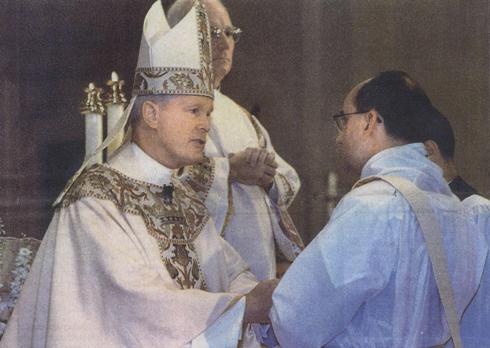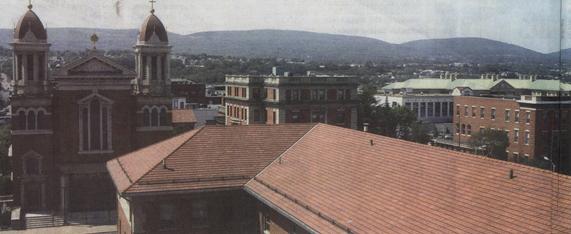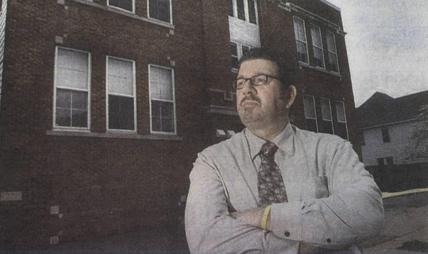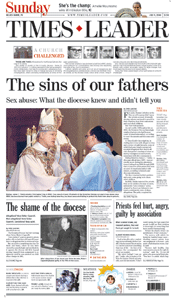The Sins of Our Fathers
Sex Abuse: What the Diocese Knew and Didn't Tell You
By Dave Janoski djanoski@leader.net
Times Leader
July 9, 2006
http://www.timesleader.com/mld/timesleader/14998976.htm
[See other articles in this feature:
- The
Shame of the Diocese: Allegations? Move Father Caparelli. More Allegations?
Move Father Caparelli. Convictions? Keep Quiet, by Dave Janoski, Times
Leader (7/9/06)
- Priests
Feel Hurt, Angry, Guilty by Association: When Scandal Breaks, Say Innocent
Pastors, They and Flock Get Caught in Turmoil, by Mary Therese Biebel,
Times Leader (7/9/06)
- Bill
Aims to Loosen Limits on Suits: Statutes of Limitations on Sex-Abuse Cases
Often Leave Victims with No Options, by Dave Janoski, Times Leader
(7/9/06)
- Crimes
and Accusations, Times Leader (7/9/06) [summaries, assignments, and
photos of accused priests]
- A
Church Re-Educates Itself: Changing Attitudes: The Catholic Church Has
Mandated Special Training to Recognize Sexual Abuse and Abusers, by
Mark Guydish, Times Leader (7/9/06)
- Morning
Note from the Newsroom: the Church Series, by Matt Golas, Times Leader
(7/11/06).]
For years, Roman Catholics in the Diocese of Scranton didn't know that
priests accused of sexually abusing minors continued to preach in their
churches, hear their confessions and teach their children.
But their bishops knew.
As early as the 1960s and as late as 2002, the Scranton Diocese knowingly
employed priests who had been accused of sexual misconduct, according
to court documents and diocesan statements.
 |
| Bishop James C. Timlin ordains Christopher
Clay in 1998. Clay, one of at least 25 priests in the Scranton Diocese
accused of sex abuse since 1950, has been barred from public ministry.
Timlin, now bishop emeritus, has been accused of failing to protect
his flock from abusive priests. Times Leader file photo. |
A Times Leader investigation, including interviews with alleged victims
and a review of eight lawsuits, some of which had gone largely unreported,
revealed allegations that church officials disregarded warnings of abuse
or merely reassigned accused priests, sometimes with dire consequences.
Bishop Emeritus James C. Timlin – a diocesan official since 1966 – was
personally aware during his administration as bishop from 1984 through
2003 that at least five of his priests had been accused of sexual misconduct
with minors, according to lawsuits and diocesan statements.
Yet they remained in their parishes and posts, some going on to abuse
other children.
What is a tragedy with
the Catholic Church is how many cases were terribly mismanaged,
where a bishop or religious superior said 30 or 40 years ago, 'OK.
You're forgiven. Don't do it again.'
Thomas Plante
Psychology professor at Santa Clara University who has written two
books on abuse by priests |
In 2002, Timlin removed five priests from active ministry because of
a new, nationwide "zero-tolerance" policy adopted by American
bishops in reaction to a nationwide wave of abuse allegations. The policy
required the removal from ministry of any priest who had been proven to
have engaged in sexual misconduct at any point in his career.
In interviews with the Times Leader shortly before the policy was adopted,
Timlin maintained it should not be applied to priests who had been accused
in the past, received treatment and returned to ministry without further
problems.
Such priests were similar to others who had been treated for alcoholism
and returned to duty, he said.
In addition to Timlin, at least two other Scranton bishops, both now deceased,
were aware of accusations against priests, but allowed those priests to
continue ministering to local Catholics, according to lawsuits.
 |
| The church hierarchy runs the diocese
from a cluster of buildings near St. Peter's Cathedral on Scranton's
Wyoming Avenue. The cathedral is at left. Times Leader staff photo
/ Aimee Dilger. |
Timlin, through a diocesan spokesman, declined to be interviewed for
this story. In an e-mail message, spokesman William Genello said the diocese
would not answer any of the Times Leader's questions about its handling
of abuse allegations:
"I must say your approach to this issue is curious – focusing on
cases that are decades old and priests who have been deceased for many
years? I certainly hope this does not reflect any personal or institutional
animosity toward the Catholic Church."
Times Leader President and Publisher Patrick McHugh defended the paper's
approach, pointing out that the investigation had uncovered new details
of already publicized cases and revealed some cases that had not been
reported before.
"While many of the cases and priests cited in the series are indeed
well in the past, a clear pattern of actions and behavior has emerged
on the part of people whose responsibilities should have led them to act
more in the interests of parishioners and those harmed. Local church leaders
appear to have failed their flock," McHugh said.
"To suggest any animosity on the part of the Times Leader or its
staff is absurd. Many of the most senior managers of the paper, including
the editor and me, are of the Catholic faith. This series will stand on
its merit."
Numerous accusations
At least 25 priests serving in the Scranton Diocese have been accused
of having sexual contact with minors since 1950, according to diocesan
reports.
The diocese has never released the names of all of the accused, but has
acknowledged sexual misconduct accusations against eight priests whose
names became public because they were arrested or sued or because their
removal from ministry became public knowledge. The Times Leader has uncovered
the names of three more, all deceased.
In 2004, the diocese reported
that 25 of its priests were accused of misconduct involving 46 minors
between 1950 and 2002. In a press release that year, the diocese said
charges against 15 of the 25 priests were "founded," but it
did not define the term or describe how a case was determined to be "founded."
A diocesan spokesman recently declined comment on the report.
The diocese's data were gathered for a nationwide study
commissioned by the U.S. Conference of Catholic Bishops that concluded
4 percent of American priests serving between 1950 and 2002 had been accused
of abuse. The percentage in the Scranton Diocese was 2.86, based on the
diocese's figures.
The 2004 study, compiled by the John Jay College of Criminal Justice using
reports submitted by Catholic dioceses and religious orders around the
country, cited other studies to suggest that abuse of minors by priests
might be less prevalent than abuse by those in other professions or American
adults at large.
"If you take studies of school teachers, that research suggests there's
about 5 percent of school teachers who have sexual contact with a minor
child," said Thomas Plante, a psychology professor at Santa Clara
University, a Jesuit university in California, who has written two books
on abuse by priests.
It's the church's mishandling of abuse cases in the past, not the numbers,
that has fueled the nationwide abuse scandal, he said.
"What is a tragedy with the Catholic Church is how many cases were
terribly mismanaged, where a bishop or religious superior said 30 or 40
years ago, 'OK. You're forgiven. Don't do it again.'
"It's the secrecy. It's the cover-up. It's the leadership making
tragic mistakes."
Costly claims
The Scranton Diocese's handling of accusations during the past 40 years
has proven costly.
Since 1995, diocesan attorneys have negotiated settlements in at least
four cases involving priests accused of sexual contact with minors, at
a cost of more than $835,000, the diocese says. Three other suits are
ongoing.
Many of the settlement details – and pertinent diocesan documents – remain
sealed from public view because of confidentiality agreements between
the diocese, other defendants and plaintiffs.
 |
| Thom Pesta in the former schoolyard in
Luzerne where he says he was fondled by his pastor, Father Lawrence
P. Weniger, decades ago. The school, Sacred Heart, has moved to a
different location. Times Leader staff photo / Clark Van Orden. |
But a Times Leader review of available documents and interviews with
victims indicate the Scranton Diocese's reaction to abuse charges has
often paralleled that of the Philadelphia Archdiocese, which was the target
of a stinging grand jury report last year.
The grand jury, which found 63 priests in the Philadelphia Archdiocese
had been credibly accused of abuse, said that diocese covered up abuse
allegations, failed to adequately investigate them and kept dangerous
priests working in jobs where they had access to more potential victims.
In its investigation of the Scranton Diocese, the Times Leader found:
• In 2000, Bishop Timlin and his then-vicar
for priests, Father Joseph R. Kopacz, were informed by other diocesan
clergy of suspicions that Father Albert M. Liberatore Jr.,
a Duryea pastor, was sexually abusing a teenage boy, according to a suit
filed in U.S. District Court in Scranton. Liberatore denied the allegations
and accused his accusers of misconduct, the suit said. Timlin never brought
the allegations to a diocesan review board set up to consider such cases
and told Liberatore and the other priests to "put the issues behind
them," the suit claims. The victim's family was not told of the allegations
and the abuse continued for two years, the suit said. Liberatore was arrested
3 1/2 years later, after Timlin retired, because of information uncovered
by a private investigator working for the diocese. Liberatore, who pleaded
guilty in the case and was sentenced to 10 years probation, is a defendant
in the victim's federal suit along with Timlin, Kopacz and the diocese.
• In 1999, church
officials in Minnesota informed Timlin, Kopacz and Auxiliary Bishop Joseph
Dougherty of allegations that Father Carlos Urrutigoity,
the head of a conservative religious society in Pike County, had engaged
in improper conduct with a Minnesota seminarian, according to a federal
lawsuit. The diocese later said the facts in the case were inconclusive.
Urrutigoity and another priest in the Society of St. John in Pike County,
Father Eric Ensey, were later accused of sexual misconduct
with a student at St. Gregory's Academy in Moscow, where the society was
temporarily housed. Ensey initiated the sexual contact in 1997, when the
boy was a 16-year-old junior at St. Gregory's, according to the suit.
In December 2001, a former associate of the society publicly revealed
the allegations against Urrutigoity and Ensey. They were suspended from
ministry by the diocese the following month. The alleged victim from St.
Gregory's sued the priests, Timlin and the diocese, among others, in March
2003. The case was settled for $454,550 last year, with the diocese paying
$200,000. Timlin's successor, Bishop Joseph Martino, withdrew the diocese's
approval for the society to operate here. It has since moved to Paraguay.
• In April 1988, Timlin received anonymous
letters alleging a Towanda priest, Father Robert Brague,
46, was involved in a relationship with a teenage girl from his parish,
according to Brague's deposition in a civil suit. Brague had initiated
sexual activity with the girl in 1987 when she was 17. Brague met with
Timlin in April 1988 and denied the allegations. Timlin took no action,
Brague testified. Four months later, after the girl became pregnant, Brague
admitted to the allegations.
He moved to Florida, where he continued to serve as a priest until his
death in 1997. The diocese and Brague settled the victim's suit in 1995.
The terms were not disclosed.
• In 1968, Bishop J. Carroll McCormick –
and Timlin, who was the bishop's secretary – were informed by a Hazleton
police officer that Father Robert N. Caparelli had been
accused of molesting two altar boys in the city. Caparelli, who denied
the charges, was sent to a Catholic rest home for a month. There he was
evaluated by a psychologist who urged the diocese to investigate the allegations
further and wrote that if they were true, the priest would probably molest
again. Caparelli was quickly reassigned to a Lackawanna County parish
and continued to serve in local schools and churches until his arrest
on sex abuse charges in 1991, during Timlin's administration as bishop.
By then he had molested four more boys, maybe more, according to his diocesan
file and lawsuits. In the 1970s, Caparelli admitted to his superior at
an Old Forge church that he had groped at least one boy there. It is unclear
if that pastor, William Giroux, ever alerted the bishop or other diocesan
officials. Caparelli died in prison in 1994, presumably because of AIDS.
• In 1962, a 12-year-old altar boy at St.
Therese's Church in Kingston Township, Thomas Harris, told Father Michael
Rafferty, a priest at his school, Gate of Heaven in Dallas, that his parish
priest, Father Francis Brennan, had fondled and sodomized
him, according to a lawsuit. Rafferty met with Harris' parents, but refused
to alert then-Bishop Jerome D. Hannan, the suit said. When approached
directly by Harris' parents, Hannan assured them Brennan would be "taken
care of," the suit said. Brennan was reassigned to a convent, but
not punished in any way, the suit said.
He remained an active priest until his death in 1974. At least one other
man claims he was sodomized by Brennan at St. Therese's during the same
period, when he was 14.
Harris could not be reached for comment.
Rafferty, retiring as pastor of Our Lady of Sorrows Church in West Wyoming,
declined comment.
Shroud of secrecy
The Scranton Diocese has consistently fought to keep information on accusations
against its priests from becoming public.
In many cases, it has asked judges to seal from public view all or some
documents in lawsuits filed by alleged victims of abuse.
"There are confidentiality issues with the records, although plaintiffs
are allowed to have them," said James E. O'Brien Jr., a Scranton
attorney who represented the diocese in all the lawsuits reviewed by the
Times Leader.
"There are accused that have been exonerated. There are some victims
that deserve some privacy."
But church critics say such secrecy is aimed primarily at protecting dioceses
from legal liability.
David Clohessy, national director of the Survivors Network of Those Abused
by Priests, said the 2002 scandal in the Boston Archdiocese, where 141
priests were accused of abuse, was uncovered only because victims' attorneys
successfully pushed for court orders to obtain diocesan documents, which
were then made public.
"That's what every bishop is afraid of," Clohessy said. "A
bishop does not want to take the witness stand and reveal how much he
knew and how little he did about these criminals."
In at least one case, the Scranton Diocese offered a cash payment to an
alleged abuse survivor in exchange for keeping silent.
William Nothoff says he was forcibly sodomized in the rectory at St. Therese's
Church in Kingston Township in the 1960s by Father Francis Brennan, whose
alleged abuse of Thomas Harris during the same period is the focus of
an ongoing lawsuit.
Nothoff told no one of the abuse for three decades, but he said it contributed
to "rough spots" in his life, including substance abuse problems.
In the mid-1990s, Nothoff told his story to a church employee in Arizona,
where he lives.
"I was literally falling apart. It felt like a grenade had gone off
in my head," he said in a recent phone interview.
The church employee contacted the Scranton Diocese, which began paying
$120 per week for counseling for Nothoff and offered him a $5,000 settlement,
provided that he never go public with his story.
Nothoff never signed the settlement and didn't take the $5,000. During
a 1995 trip to Northeastern Pennsylvania for a family wedding, he gave
an interview to the Times Leader, which printed his story, without revealing
Brennan's name. The diocese promptly stopped the counseling money, he
said.
In an interview with the Times Leader at the time, Monsignor Neil Van
Loon, diocesan chancellor in 1995, described the $5,000 offer as an act
of "mercy or kindness," because there was no way to prove or
disprove Nothoff's allegations.
Van Loon said Brennan "had a good record with nothing to indicate
anything but a clean record."
But Van Loon said the diocese was concerned Nothoff might sue, even though
the statute of limitations would have expired decades earlier:
"We're not going to waste $5,000 and then have him attempt to sue
us. It would be public, we would have to get legal counsel ... and for
what end?"
It's unclear if Van Loon or other diocesan officials in the 1990s were
aware of the accusations against Brennan allegedly made to Bishop Hannan
by Thomas Harris and his parents in 1962.
Van Loon, now a diocesan official stationed near Williamsport, declined
comment through a diocesan spokesman.
Trying to help
Some alleged victims of abuse by priests say they aren't interested in
suing, but are motivated to go public to protect children from similar
abuse.
Thom Pesta said that until the nationwide priest abuse scandal broke in
2002, he thought Monsignor Lawrence Weniger was just a "lone, sick
man."
"I always thought it was an isolated event. Then I found out it was
not."
Pesta said he and other boys at Sacred Heart School and Church in Luzerne
were fondled by Weniger more than 40 years ago. The incidents happened
on the playground, in the sacristy and on church grounds, Pesta said.
"We had a little support group. We laughed about it. I don't know
if it was because it was funny."
Pesta said he told his parents about Weniger, but they didn't believe
him.
"I refuse to believe the bishop didn't find out about this. I find
it hard to believe that for all the kids it happened to, this never came
out."
Pesta said he believes the incidents contributed to his withdrawn nature
as a child and might be one of the reasons he has shunned organized religion
as an adult.
"It's not like my world crumbled. But I spent much of my time alone.
"I had led a tortured childhood but the rest of my life was fine."
Pesta grew up to work as a musician and as an operations director at Walt
Disney World in Florida. He now works at Guard Insurance and lives in
Kingston.
Weniger died in 1972.
When the allegations of abuse by priests in Boston and other dioceses
began receiving media attention in 2002, Pesta asked for a meeting with
then-Bishop Timlin about Weniger.
In an interview with the Times Leader from that period, Timlin acknowledged
there had been allegations about Weniger after his death:
"I knew him, but we never knew anything about this. There have been
several people who have accused him. Because of all the publicity, I did
talk to somebody about that. I apologized. I never knew anything about
it."
Pesta recalls his meeting with Timlin somewhat differently.
"He basically said, 'I'm sorry you left the church.' He was certainly
not admitting or denying anything.
"He said what you would expect a politician to say."
THE SERIES
These are times of transition for the Roman Catholic Diocese of Scranton.
The center of gravity in the 11-county diocese – home to 355,000
Catholics – is shifting eastward to the fast-growing Poconos. While
many churches in Luzerne and Lackawanna counties have been forced to close
or merge because of shrinking congregations, others are being revitalized
by an influx of Hispanic parishioners.
The number of priests has declined by half since 1960, adding more pressure
for consolidations and closings and expanding the roles of lay church
volunteers.
Catholic parents who grew up in an era of inexpensive and thriving elementary
and secondary schools now find their choices limited, as the diocese closes
school after school, citing financial pressures and declining enrollments.
Also, the diocese’s leadership finds itself confronted with allegations
that it mishandled sex abuse charges against some of its priests, with
victims’ advocates calling for legal changes that could open the
diocese to increased liability.
Today, the Times Leader begins a four-part series on a church challenged.
Today: The Scranton Diocese stands accused of not doing enough to protect
parishioners from abusive priests.
Next Sunday: The dwindling number of priests puts more pressure on those
who remain and provides new possibilities and responsibilities for lay
volunteers.
Sunday, July 23: Falling enrollment and financial pressure have whittled
away at the diocese's school system, and more school closings are likely.
Sunday, July 30: What will the diocese of the future look like?
LEARN MORE
• For more information on the issue of sexual abuse by priests,
go to the following Web sites:
www.snapnetwork.org:
Survivors Network of Those Abused by Priests
www.usccb.org/nrb:
U.S. Conference of Catholic Bishops National Review Board
www.bishop-accountability.org:
A large collection of documents related to abuse by priests
www.virtus.org:
National Catholic Risk Retention Group Inc.
www.dioceseofscranton.org:
Diocesan site contains information on programs to prevent abuse
Times Leader Associate Editor/Investigative Dave Janoski may be reached
at 829-7255.
|




